
The Epic of Evolution and Humanity's Great Turning
By Jerry Riverstone, for Evolution-Local
Introduction
Across the long arc of history, the world's diverse cultures created varied and colorful cosmologies, big-picture stories that told how the world came to be and where people fit into the grand scheme. Today we live in a historical moment that is vastly different from anything our ancestors could have imagined, even as recently as a couple generations ago. Human activity has radically transformed the planet in the last 50 years, a period appropriately referred to as the Great Acceleration.
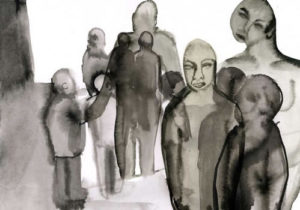 While changes in technology and the state of the world have been accelerating, our prevailing cosmology has not kept up. We still operate on a disjointed and often contradictory mix of explanations: fragments of 2000-year old religious myth, 18th Century Enlightenment philosophy, and more modern scientific facts -- plus a postmodern suspicion of any "grand narrative" at all. Lacking a shared story that can orient us at this pivotal time in our history, our globalized civilization remains mired in confusion, conflict, and the escalating degradation of our biosphere.
While changes in technology and the state of the world have been accelerating, our prevailing cosmology has not kept up. We still operate on a disjointed and often contradictory mix of explanations: fragments of 2000-year old religious myth, 18th Century Enlightenment philosophy, and more modern scientific facts -- plus a postmodern suspicion of any "grand narrative" at all. Lacking a shared story that can orient us at this pivotal time in our history, our globalized civilization remains mired in confusion, conflict, and the escalating degradation of our biosphere.
We need a coherent and believable cosmology that can inspire, unify, and guide us, providing direction and meaning in our lives. Luckily, just such a story exists. The Epic of Evolution, or Universe Story, is an emerging cosmology that weaves together the prevailing scientific and historical accounts of reality, as well as philosophical and spiritual insights, into a cohesive, compelling, and awe-inspiring story. The resulting narrative portrays our Universe not merely as a static collection of objects, but as a singular and ongoing evolutionary process. The living world we are part of is not merely a one-time Creation from long ago, but is an ever-present dynamic that philosopher Teilhard de Chardin described as cosmogenesis. This work-in-progress has been continuously unfolding for at least the past 13.8 billion years -- and is still happening as you read these words.
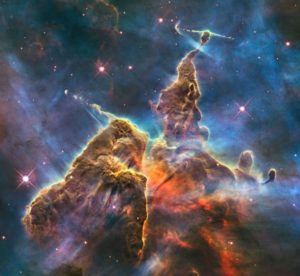 As seen through the Epic, the Universe we are part of is creative, self-organizing, and tending toward ever-greater complexity and new forms of expression. What seems to have started as pure energy eventually blossomed into hydrogen atoms, stars and galaxies, planets, living cells, complex ecosystems, vast herds of migrating caribou, spiritual awareness, and symphony orchestras.
As seen through the Epic, the Universe we are part of is creative, self-organizing, and tending toward ever-greater complexity and new forms of expression. What seems to have started as pure energy eventually blossomed into hydrogen atoms, stars and galaxies, planets, living cells, complex ecosystems, vast herds of migrating caribou, spiritual awareness, and symphony orchestras.
While there is much about our Universe that remains shrouded in mystery, the Epic of Evolution is the most accurate story we have, based on the best available evidence. And what a story it is! Contemplating and incorporating the Epic into one's worldview can open a gateway to a deeper understanding of reality and an immeasurably richer and more vibrant experience of being alive.
This current piece gives a brief overview of the Epic in ten chapters, concluding with reflections on how the story can help humanity navigate the biggest challenge we have faced as a species. The Chapters are:
- Our Universe at the Beginning of Time
- Galaxies, Stars, and Earth
- Earth Comes Alive
- Life gets Big and Strange
- Successive Waves of Creatures
- Early Humans
- Agriculture and Civilization
- The Age of Capitalism
- Our Anthropocene Predicament
- The Great Turning
The early chapters are in the domain of natural or “hard” sciences like physics, astronomy, chemistry, biology. The later chapters are more interpretive and draw from the humanities and social sciences. A list of books, websites, and videos is provided at the end for further exploration. That said, none of the authors cited is responsible for the interpretations or conclusions reached in this present version of the Epic.
Chapter One: Our Universe at the Beginning of Time
The early Twentieth Century was marked by radical changes to our view of the Universe. Prior to the 1920s it was not known, for example, if there was just one galaxy, or many. Yet a gaze through Edwin Hubble's telescope, combined with some calculations, showed that not only was there more than one galaxy, there were millions -- billions even. Shortly afterward humanity was introduced to one of the strangest notions ever about the world we inhabit. That idea, predicted by Albert Einstein's equations and corroborated by Hubble's astronomical observations, is that the Universe is expanding. Based on subsequent efforts to project the galaxies' movements back through time, it appeared as if they had all traveled outward from a single point. This led to a hypothesis -- supported in the years since by varied evidence -- that the Universe originated with a so-called "Big Bang" (although it was not yet big, and there was no bang) from a starting condition as a single point of hot compressed energy and matter.
One point worth noting, is that while the Universe had a powerful expansionary quality, there was also the opposing force of gravity, which prevented everything from just flying apart. Without that inward and attractive force nothing would stick together, and matter would not form beyond the smallest particles.
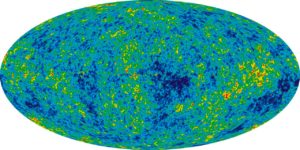 According to theoretical astrophysicists, in the early micro-moments of rapid expansion, the first neutrons and protons formed, followed a few minutes later by the first ephemeral atoms of hydrogen and helium. Yet the early Universe was so hot and chaotic as to be nearly structureless. The next few hundred million years is thought to have been a dark age in which the universe consisted of hot and opaque plasma that did not allow the passage of light. I imagine a dark space permeated by the sound of radio static.
According to theoretical astrophysicists, in the early micro-moments of rapid expansion, the first neutrons and protons formed, followed a few minutes later by the first ephemeral atoms of hydrogen and helium. Yet the early Universe was so hot and chaotic as to be nearly structureless. The next few hundred million years is thought to have been a dark age in which the universe consisted of hot and opaque plasma that did not allow the passage of light. I imagine a dark space permeated by the sound of radio static.
Chapter Two: Galaxies, Stars, and Earth
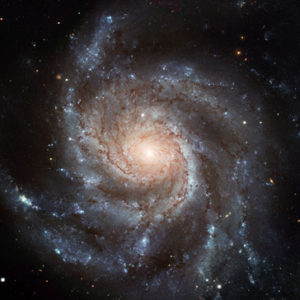 By around 400 million years after the Big Bang, and possibly earlier, the universe was cooling and beginning to coalesce into clumps of matter -- the first stars and galaxies. In the heart of the first stars, atoms of lighter elements like helium were forged into heavier elements like carbon, oxygen, silicon, and iron. Many of the other elements that comprise our solar system today, including our bodies, were created when massive stars reached the end of their life and exploded as extremely hot supernovae. Each such event left behind a cloud of gas and stardust called a nebula that was seeded with additional elements such as calcium, magnesium, and gold.
By around 400 million years after the Big Bang, and possibly earlier, the universe was cooling and beginning to coalesce into clumps of matter -- the first stars and galaxies. In the heart of the first stars, atoms of lighter elements like helium were forged into heavier elements like carbon, oxygen, silicon, and iron. Many of the other elements that comprise our solar system today, including our bodies, were created when massive stars reached the end of their life and exploded as extremely hot supernovae. Each such event left behind a cloud of gas and stardust called a nebula that was seeded with additional elements such as calcium, magnesium, and gold.
Our own galaxy, the Milky Way, was formed early in the history of the Universe, some 12 or 13 billion years ago. Within its spiral arms are regions of star formation that remain active today. And located among the Milky Way's 100 billion stars is an inconspicuous medium sized star, our Sun. The Sun is believed to have originated some 4.7 billion years ago, when a portion of an interstellar nebula collapsed under gravity, giving birth to a new star.
After the Sun formed, it was orbited by a disc of matter -- gases, stardust and other debris -- that remained after the nebula’s collapse. Eventually this matter collided and aggregated, forming Earth and the other planets, moons, and asteroids of our solar system. As early as 1755, the natural philosopher Immanuel Kant had proposed this type of 'Nebular Hypothesis' for the Earth’s formation. He also believed, by extension, that many other stars were likely to be orbited by inhabited planets.
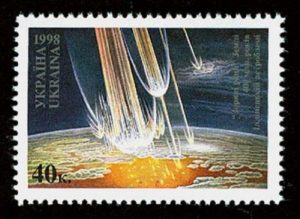 In the earliest age of Earth, referred to as the Hadean, the planet was a vast sea of molten rock, with a noxious atmosphere of ammonia and other gases. As the planet began to cool it was repeatedly interrupted by heat-generating collisions with the abundant asteroids, comets, and meteors that littered interplanetary space at that time. The largest cataclysm came when another planet-sized body crossed paths with Earth, and the colossal impact resulted in the formation of our moon. The many comets that struck Earth also brought great quantities of ice that melted on arrival. But before any lasting oceans could form, the water was evaporated into the atmosphere.
In the earliest age of Earth, referred to as the Hadean, the planet was a vast sea of molten rock, with a noxious atmosphere of ammonia and other gases. As the planet began to cool it was repeatedly interrupted by heat-generating collisions with the abundant asteroids, comets, and meteors that littered interplanetary space at that time. The largest cataclysm came when another planet-sized body crossed paths with Earth, and the colossal impact resulted in the formation of our moon. The many comets that struck Earth also brought great quantities of ice that melted on arrival. But before any lasting oceans could form, the water was evaporated into the atmosphere.
Chapter Three: Earth Comes Alive
As impacts with space objects became less frequent and the planet gradually cooled, a thin crust formed on the surface of molten Earth. The rains that fell in tremendous deluges accumulated over millions of years, forming the planetary ocean.
Many biologists believe that it was there in the depths of the early ocean that the first bits of living matter appeared, less than a billion years after Earth's formation. Complex organic compounds -- some of which may have been brought to Earth by comets – may have already been present in the oceanic 'primal soup'. Geothermal vents on the seafloor may have provided a steady source of energy for the countless chemical reactions that could have resulted in self-replicating strands of ribonucleic acid (RNA), and eventually, the first living cells.
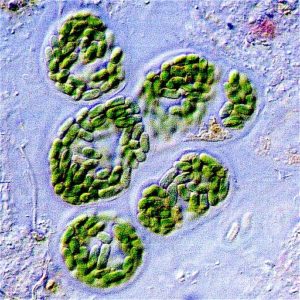 Essential to the first cells was the cellular membrane, the semipermeable container that distinguished organism from environment. Yet the membrane was not merely a protective sack. It also embodied a form of intelligence and discernment. In its role as gatekeeper the membrane determined which type of particles were good to pass, and which needed to remain on the other side. This and other bacterial capabilities were experimented with and improved upon during the two billion years or so when life was restricted to single-celled marine organisms. During this time many of the basic structures and biochemical pathways were established that enabled future life forms to prosper, things like photosynthesis, cellular respiration, motility, and the ability of an organism to coordinate several complex activities at once.
Essential to the first cells was the cellular membrane, the semipermeable container that distinguished organism from environment. Yet the membrane was not merely a protective sack. It also embodied a form of intelligence and discernment. In its role as gatekeeper the membrane determined which type of particles were good to pass, and which needed to remain on the other side. This and other bacterial capabilities were experimented with and improved upon during the two billion years or so when life was restricted to single-celled marine organisms. During this time many of the basic structures and biochemical pathways were established that enabled future life forms to prosper, things like photosynthesis, cellular respiration, motility, and the ability of an organism to coordinate several complex activities at once.
It was also in this period of Earth history that living organisms first had a collective impact of planetary significance. Since most bacteria at the time released oxygen as a metabolic waste product, Earth's atmosphere and ocean were becoming toxic to life. In what may have been the first large-scale environmental crisis, life rose to the occasion by evolving new organisms with the ability to metabolize oxygen. Ever since that time, the planet’s bacteria, phytoplankton, and algae have collectively maintained the atmospheric conditions necessary for more complex lifeforms' survival. Creative response to a crisis opened the pathway to new evolutionary realms.
Chapter Four: Life Gets Big and Strange
The earliest microorganisms of the Precambrian Era were all single-celled, and reproduced via mitosis, splitting and making a near duplicate copy of themselves. Around two billion years ago life took things to another dimension entirely with the advent of multicellularity. Now different types of structures and specialized activities could be relegated to different parts of the organism, and creatures could get larger. That advance, plus two parallel developments -- sexual reproduction and death -- enabled the blossoming of evolutionary complexity. With sexual reproduction, each successive generation of offspring inherited genes from two distinct parents, and novelty was continually produced. Features that came in handy were retained. Death freed up space and resources for subsequent generations.
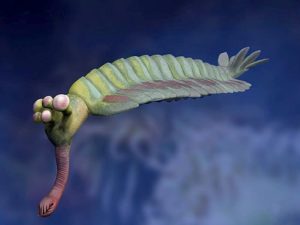 While multicellularity had humble beginnings, with time there emerged what we might identify as legitimate creatures. Along came animals with differentiated bodily systems for respiration, circulation, and digestion, and familiar parts like a mouth, digestive tube, and anus; things that could squirm, wriggle, and eventually even see where they were going. During the Cambrian Explosion, one of the planet's most important periods of biological evolution, the prototypical body plans for all of the major animal phyla were established. By 500 million years ago, the seas were plied by fantastical animals that were well-preserved in the fossil record, including the armor-shelled trilobites, the carnivorous anomalocaridids, and opabinia, the latter having five eyes, each on its own stalk, and a proboscis that terminated in a spiny grasping claw.
While multicellularity had humble beginnings, with time there emerged what we might identify as legitimate creatures. Along came animals with differentiated bodily systems for respiration, circulation, and digestion, and familiar parts like a mouth, digestive tube, and anus; things that could squirm, wriggle, and eventually even see where they were going. During the Cambrian Explosion, one of the planet's most important periods of biological evolution, the prototypical body plans for all of the major animal phyla were established. By 500 million years ago, the seas were plied by fantastical animals that were well-preserved in the fossil record, including the armor-shelled trilobites, the carnivorous anomalocaridids, and opabinia, the latter having five eyes, each on its own stalk, and a proboscis that terminated in a spiny grasping claw.
Chapter Five: Successive Waves of Creatures
Earth's deep history, also known as geological time, can be seen as an evolutionary drama in several acts. In each new act the set and scenery change. This begins with the planet's crust, fractured as it is into several shifting plates whose motions are driven by heat from deep within the mantle. As the plates shift, land masses continually reconfigure, coming together and spreading apart. Mountain chains form when plates collide and buckle. Rift valleys cleave and new seas seep in as the plates spread apart. Meanwhile the climate has also varied, including extreme events on the temperature spectrum with names like “Snowball Earth” and “Greenhouse Earth”. Great ice sheets have advanced and retreated as the planetary tilt and orbit fluctuate. Phases of planetary warming and glacial melting have ensued when volcanic activity spews great volumes of CO2 into the atmosphere. Sporadic asteroid strikes causing widespread devastation typically signal the end of one act in the drama, and the beginning of something new.
Just as the planet's scenery changes in each act, so too does the cast of characters, the flora and fauna. After a mass extinction event at the end of the Cambrian Period, there came an age when the bony fishes were in the evolutionary spotlight, and diversified greatly. Their basic vertebrate body plan -- with a head, spinal column and ribs, forelimbs and hind limbs -- proved to have lasting effectiveness. As a motif it has worked well for fish, dinosaur, reptile, bird, and mammal alike.
It was also during the middle Paleozoic Era that both plants and animals emerged from the oceanic realm and colonized dry land. This entailed such evolutionary feats as developing roots, seeds, eggshells, and temperature regulation. A green cloak spread over the planet's varied landforms, together with complex soil ecosystems. Vast swamps and primitive forests were populated by new kinds of creatures. With time and persistence, swimming, squirming and lurching led in turn to crawling, walking, running, leaping, and flying.
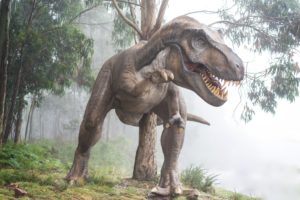 In the Mesozoic Era, or age of dinosaurs, life became faster and more ferocious. Along with long necks and tails, defensive spikes, and earth-shaking massiveness, dinosaur intelligence manifested in parental care of young, social interaction, and group hunting. Alas many of these advances reached an evolutionary dead end when an asteroid strike brought an end to the Mesozoic. Fortunately dinosaurs' feathered relatives, the birds, managed to survive the catastrophe.
In the Mesozoic Era, or age of dinosaurs, life became faster and more ferocious. Along with long necks and tails, defensive spikes, and earth-shaking massiveness, dinosaur intelligence manifested in parental care of young, social interaction, and group hunting. Alas many of these advances reached an evolutionary dead end when an asteroid strike brought an end to the Mesozoic. Fortunately dinosaurs' feathered relatives, the birds, managed to survive the catastrophe.
 The Cenozoic Era that followed was marked by the rise of mammals. Animals with fur, lactation, and live birth had evolved during the Mesozoic, but tended to be small and reclusive. With so many niches having been vacated by the dinosaurs, mammals flourished. Great herds of grazing and browsing ungulates spread out across the vast grasslands and savannas, along with their predators, the canines and great cats. In the forests new primate species appeared, adapted for life in the trees with grasping hands and tails, and complex social behaviors.
The Cenozoic Era that followed was marked by the rise of mammals. Animals with fur, lactation, and live birth had evolved during the Mesozoic, but tended to be small and reclusive. With so many niches having been vacated by the dinosaurs, mammals flourished. Great herds of grazing and browsing ungulates spread out across the vast grasslands and savannas, along with their predators, the canines and great cats. In the forests new primate species appeared, adapted for life in the trees with grasping hands and tails, and complex social behaviors.
If the story of life on Earth had ended there in some cataclysmic flash, the Epic of Evolution would have been an excellent tale regardless, full of drama, interesting characters, battles against adversity, and plenty of suspense and surprises. But there would have been no one to tell the tale, or hear it. Yet instead of ending, the story would become even stranger, with a new protagonist.
Chapter Six: Early Humans
Around 5 million years ago in the heart of Africa the evolutionary lineage that would lead to humans departed from that of our nearest relatives, the chimpanzees and bonobos. In the ensuing millions of years, our ancestors began to walk upright, their brains steadily increased in size, and they developed a knack for making and using a wide variety of stone tools.
Members of the genus Homo have been around for 2.6 million years, and during the many millennia in which our humanness emerged, a primordial template for our way of life was established. Life would have been spent among a small multigenerational group of 15-30 people in the midst of wild nature. Days were for hunting, fishing, and gathering, processing plant and animal foods, and doing other handiwork, while nights were spent around the fire, looking out at the Milky Way, telling and listening to stories.
The first Homo sapiens had evolved by around 300,000 years ago. Exactly how and when self-reflective consciousness and symbolic language arose is a mystery. By around 40-50,000 years ago, cultural and spiritual expression was well underway, as evidenced by elaborate cave paintings, carvings of figurines, beadwork, and ritual burial sites.
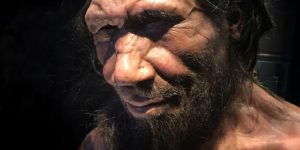 From their African origins, multiple waves of humans spread outward to Europe and Asia. Recent genetic studies have shown that as modern humans left Africa on their way to peopling the continents, they encountered and interbred with archaic humans that had previously left Africa. These included the Neanderthals in Europe and western Asia, the Denisovans from Siberia to Southeast Asia, and others.
From their African origins, multiple waves of humans spread outward to Europe and Asia. Recent genetic studies have shown that as modern humans left Africa on their way to peopling the continents, they encountered and interbred with archaic humans that had previously left Africa. These included the Neanderthals in Europe and western Asia, the Denisovans from Siberia to Southeast Asia, and others.
Modern hubris and the mists of time have diminished our notions of what prehistoric humans were like. Rather than being stupid and brutish, they would have typically been in top physical shape, alert and attuned to what was happening around them, courageous, industrious, skillful as craftspeople, reverent, and with a richness and subtlety of ecological knowledge and understanding that is beyond our present comprehension. They spent their days and nights in communion with plants, animals, rivers and the wind, always immersed in wild nature. Those are the kind of people we all have among our ancestors. Through generations of trial, error, and hard-won wisdom, they earned much of what we have been bequeathed with today.
Most of the planet's habitable areas were populated by hunter-gatherers several millennia ago, and a global mosaic of thousands of locally-rooted indigenous cultures resulted. Even today an estimated 7,000 languages exist in the world, although most are at risk of extinction.
Chapter Seven: Agriculture and Civilization
Prehistoric humans evolved in the Pliocene and Pleistocene epochs, when the planet was undergoing major ecological changes due to the advance and retreat of glaciers. Survival required both geographic mobility and adaptability. As climatic conditions improved following the last glacial period some 10,000 years ago, hunter-gatherers in areas including today’s Turkey, Syria, and the Levant began to domesticate wheat. The process of domesticating plants and animals -- which was independently achieved during the Neolithic period in locations as far-flung as the Fertile Crescent, China, New Guinea, Mesoamerica, and the Andes -- set in motion a chain of events that would change the course of human and planetary history.
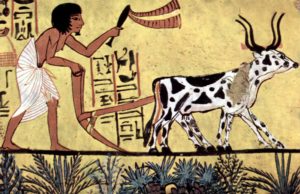 The domestication of other species can also be understood as instigating the gradual domestication of Homo sapiens. After a couple million years of living in wild places among small egalitarian groups, domestication and agriculture led to an increase in sedentary village and town life, growing populations, and more complex forms of social organization. In the process, the innate spiritual or mystical connection between humans and wild nature was gradually replaced with a preoccupation with human affairs and anthropomorphic deities.
The domestication of other species can also be understood as instigating the gradual domestication of Homo sapiens. After a couple million years of living in wild places among small egalitarian groups, domestication and agriculture led to an increase in sedentary village and town life, growing populations, and more complex forms of social organization. In the process, the innate spiritual or mystical connection between humans and wild nature was gradually replaced with a preoccupation with human affairs and anthropomorphic deities.
In Mesopotamia, large-scale irrigation works were constructed, requiring the mobilization of a large labor force under centralized control. By 5,000 years ago, early urban life and civilization were well underway, aided by inventions including metallurgy, numerical systems, money, writing, record-keeping, taxation, and formalized property rights and legal codes. The first urban centers were hubs for commerce, specialized craftspeople, government officials, priests, kings, and large temples. Social stratification and slavery arose, as did the concentration of wealth and power in the religious and governing elite.
As the reach of neighboring Mesopotamian city-states expanded, so did competition for agricultural lands and water supplies. In that context arose armies and warfare, fought with bow and arrow and spears. When the victors subjugated and incorporated the defeated into their sphere of control, the first empires resulted.
Early civilizations and empires arose in present-day China, Egypt, and India, as well as coastal Peru, the Andes, and Mesoamerica. These were followed by the classical civilizations of Greece and Rome, plus a succession of civilizations and empires that rose and fell across Eurasia, Africa, and the Americas.
Historians have offered multiple reasons for the collapse of civilizations, including internal rebellion against the unsustainable demand of elites, overcomplexification, and environmental destruction, including deforestation, erosion, and soil exhaustion. While many civilizations appeared and dissolved, the overall trends of technological innovation and increasingly complex cultural expression would continue to blossom into modern times.
In the Western world, empire became synonomous with patriarchy and male-dominated religion. In the Abrahamic religions that still dominate the world today, an omnipotent male god is believed to have created the entire world, making men superior to women and granting them power and privilege in the family, as well as economic affairs and governance.
Chapter Eight: The Age of Global Capitalism
Just over 500 years ago a sequence of events began to unfold that would propel humankind to multiply its numbers and become a transformative planetary force.
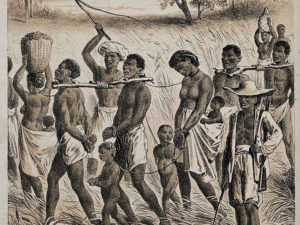 Europeans' transatlantic voyages opened up new worlds of opportunity, and the resulting genocide of indigenous peoples made native lands available for the taking. Imported African slaves provided labor for tobacco and sugar plantations, and the wealth derived from plantation products helped finance England's Industrial Revolution. New tools and ways of organizing labor brought unprecedented efficiency and productivity to all types of manufacturing activities. In addition to running factory equipment, coal-burning steam engines also powered steamboats and then locomotives in England, Europe and America. Factory workers, including children, lived and worked under dismal conditions, yet urbanization quickened and populations increased.
Europeans' transatlantic voyages opened up new worlds of opportunity, and the resulting genocide of indigenous peoples made native lands available for the taking. Imported African slaves provided labor for tobacco and sugar plantations, and the wealth derived from plantation products helped finance England's Industrial Revolution. New tools and ways of organizing labor brought unprecedented efficiency and productivity to all types of manufacturing activities. In addition to running factory equipment, coal-burning steam engines also powered steamboats and then locomotives in England, Europe and America. Factory workers, including children, lived and worked under dismal conditions, yet urbanization quickened and populations increased.
The emergence of industrial civilization was rooted in the ideas of the 18th Century European Enlightenment. Rational, empirical, and scientific approaches to understanding the world displaced a literal biblical cosmology. Old bonds of religion, community, and place diminished, replaced by new and compelling notions of freedom, progress, and commerce, along with a collective quest for useful knowledge. This was aided by advances in physics, chemistry, mathematics, and other fields. Nature was increasingly seen as a mechanical entity that could be deciphered and manipulated to serve society's growing economic aspirations.
The century after 1850 brought steel manufacturing, widespread electrification, and eventually the petroleum and automobile industries. Together with modern pharmaceuticals, cheap and abundant oil allowed the global population to skyrocket after 1950. Oil was used for the manufacture of fertilizers and agrochemicals, which greatly increased agricultural productivity. Cheap fuel for land and air transport also allowed food to be more easily distributed globally. Overall, the surplus energy from oil led to an unprecedented jump in material wealth and consumption -- at least for some people.
Although the last colonial empires were officially dismantled after World War II, prosperity in the so-called developed world continued to rely on coercive international relations. Through political, economic, and military pressures, impoverished nations were exploited by imperialist powers as sources of agricultural commodities (e.g. coffee, sugar, cotton), cheap natural resources (oil, minerals, timber), and cheap labor. With their nations' best agricultural lands appropriated and dedicated to export crops, small farmers were forced to relocate to less-productive and ecologically fragile lands, leading to deforestation, erosion, and hunger. This legacy continues today, with the worst poverty and pollution concentrated largely in the "Global South", and climate change projected to impact developing countries more severely than elsewhere.
While the seeds of inequality were sown with the dawn of agriculture, and sprouted in early civilizations, under the neoliberal economic policies of recent decades, inequality has reached new extremes. Alliances between transnational corporations, the finance sector, national governments and military forces have resulted in wealth and power becoming ever more concentrated in a global elite. A handful of banks, food, media, technology, and energy corporations dominate the global economy, and currently a few dozen individuals hold as much wealth as 50% of the world's population.
In so-called capitalist democracies -- actually something of an oxymoron -- economic and political power are tightly coupled, making it difficult to democratically advance social and environmental reforms that might threaten the status quo. Those with great spending power influence public opinion and the political process through advertising, media ownership, and financing electoral campaigns. With a majority of elected officials beholden to their wealthy backers, corporate lobbyists successfully shape legislative agendas and government policies. The arrangement resembles legalized and institutionalized corruption more so than true democracy. As a result, our legal, financial, and monetary systems have been incrementally modified to favor entrenched interests, prioritizing private profits and wealth accumulation above all else, and the vicious political-economic cycle continues.
 Intimacy between governments and corporate and financial interests affects varied spheres of modern life including food and nutrition, healthcare, and the criminal justice system -- not to mention our relationship with the planet. Corporations are ultimately responsible only for maximizing shareholder profit, and continually advocate for weaker environmental protection regulations. Fossil fuel companies carry enormous political influence and governments have been reluctant to place any significant price on greenhouse gas pollution. The military-industrial complex siphons off vital economic resources that could be going to finance the world's transition to renewable energy systems. Meanwhile, citizen movements to oppose corporate agendas must be ready to confront both corporate lawyers and the criminalization of peaceful protest. This makes it increasingly difficult to safeguard social and environmental protection through democratic means.
Intimacy between governments and corporate and financial interests affects varied spheres of modern life including food and nutrition, healthcare, and the criminal justice system -- not to mention our relationship with the planet. Corporations are ultimately responsible only for maximizing shareholder profit, and continually advocate for weaker environmental protection regulations. Fossil fuel companies carry enormous political influence and governments have been reluctant to place any significant price on greenhouse gas pollution. The military-industrial complex siphons off vital economic resources that could be going to finance the world's transition to renewable energy systems. Meanwhile, citizen movements to oppose corporate agendas must be ready to confront both corporate lawyers and the criminalization of peaceful protest. This makes it increasingly difficult to safeguard social and environmental protection through democratic means.
Chapter Nine: Our Anthropocene Predicament
From a certain vantage point, industrial capitalism has been wildly successful. As a vehicle for driving human innovation, technological progress, and population growth, capitalism has delivered great material wealth, life-saving medical advances, air travel, breakthroughs in communications and computing, and supermarkets filled with foods from around the planet. Dazzled by and dependent on these wonders, capitalism's proponents defend it as the best system ever.
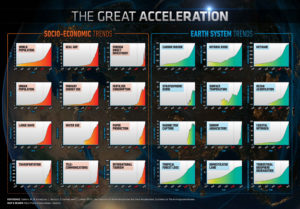
Yet behind its veneer of superiority, capitalism can be seen as means for pillaging the planet as quickly and efficiently as possible, for the short-term benefit of a small minority. Overconsumption in the rich nations (led by the US), along with China's growing middle class has accelerated the conversion of Earth's natural habitats to consumable goods. The annual global consumption of natural resources more than tripled between 1970 and 2010 -- demonstrating why recent decades have been called The Great Acceleration. During that same timeframe global populations of vertebrate species including mammals, birds, amphibians, and fish, have plummeted by 58%. In addition, recent studies show that not just populations of larger animals, but also insects, are being decimated. Insects play vital ecological roles such as providing food for larger animals, and pollinating plants, including many food crops. In the midst of our technological progress, we have been laying waste to the ecological foundations that support civilization and the larger web of life.
The current chapter of the Epic of Evolution has been deemed worthy of a new name, the Anthropocene. This is the geological epoch in which human activity has become the dominant factor changing the planet's chemistry, natural cycles, ecosystems and climate.
 The ongoing loss of ecosystems and biodiversity is compounded and reinforced by accelerating global climate change -- a threat unlike anything humanity has ever faced. Despite international accords, the global consumption of fossil fuels and the resulting carbon emissions have continued to not just hold steady, but increase. Indeed, this past year has seen an unprecedented and stark outcry from scientists, the United Nations, and global citizens' movements. The message is clear: the path we are on leads to runaway global warming, great suffering, the collapse of civilization, and mass extinction, possibly including that of humankind. Changing course will entail a radical shift in the ways we think and behave.
The ongoing loss of ecosystems and biodiversity is compounded and reinforced by accelerating global climate change -- a threat unlike anything humanity has ever faced. Despite international accords, the global consumption of fossil fuels and the resulting carbon emissions have continued to not just hold steady, but increase. Indeed, this past year has seen an unprecedented and stark outcry from scientists, the United Nations, and global citizens' movements. The message is clear: the path we are on leads to runaway global warming, great suffering, the collapse of civilization, and mass extinction, possibly including that of humankind. Changing course will entail a radical shift in the ways we think and behave.
"Every day I am faced with the challenges of our troubled and complex world. But none of them loom as large as climate change. If we fail to meet the challenge, all our other challenges will just become greater and threaten to swallow us. Climate change is, quite simply, an existential threat for most life on the planet — including, and especially, the life of humankind." António Guterres (UN Secretary-General)
Chapter Ten: The Great Turning
Having reflected briefly on the entire span of cosmic, planetary, and human evolution, and having seen the predicament we find ourselves in, where does that leave us? What will the next chapter be in the Epic of Evolution?
Before exploring the chapter to come, let's re-cap a few points:
- Our Universe and that which we call "reality", is, in the ancient sense of the word, a miracle, something worthy of wonder. The Universe is an ongoing evolutionary process of creative transformation. We are part of an ever-emergent reality in which pure energy took form as matter, quarks, atoms, molecules, stars, planets, rocks, rivers, seahorses, hummingbirds, poetry, and song.
- We are blessed to inhabit an extraordinary planet with abundance to meet our every need, and a seemingly endless variety of lifeforms and beauty all around us. Human well-being is inseparable from an ecologically thriving planet.
- While humans are an exceptional species in so many ways, our success and our excess have led the planet to the brink of ecological catastrophe.
- Our prevailing economic, political, and legal institutions have been designed to prioritize economic growth, consumption, and the pursuit of material wealth. As a result of corporate capitalism, both wealth and political power are concentrated in a global elite that resists change.
If we continue along the trajectory of the Great Acceleration, the next chapter in the Epic will be a tale of struggle amidst growing chaos for our children, grandchildren, and beyond. Every decade that passes without a transformation of how we inhabit the planet will see accumulating extreme storms, flooding and drought, with clear potential for crop loss, famine, disease, mass migration of refugees, ecological degradation, and eventually the collapse of economic and political systems -- likely accompanied by war and nuclear catastrophe.

How might we work at unraveling this predicament? How can we evolve in ways that are intelligent, significant and rapid? How can we re-inhabit the places where we live, learning to live there as an integral part of local ecosystems? How do we promote humanity's unification and transformation to a life-affirming species? These are the goals of the Great Turning, an unprecedented global social movement that combines ecological, technological, political, cultural, and spiritual dimensions. While similar in some ways to previous shifts like the rise of agriculture, the Industrial Revolution, and the Digital Age, humanity's Great Turning will require both local action and global collaboration on an unprecedented scale.
Central tasks for the Great Turning are stabilizing Earth's climate, creating an ecological and socially just civilization, and retrofitting our infrastructure, our land-use, and our livelihoods in accord with ecological and regenerative principles. This includes replacing fossil fuels with renewable forms of energy (and lowering our overall energy use), and growing food in ways that build healthy soil while sequestering atmospheric carbon. Wherever possible, sourcing our food and other goods from our local bioregions will reduce the need for energy-intensive long-distance shipping. In addition to striving for a net zero carbon future we can also work to eliminate waste and pollution via circular economy principles. Through efforts such as Transition Towns, permaculture, alternative currencies, ecovillages, and countless other initiatives many people are already working together to imagine and create a resilient future.
Creating a social and political climate where these changes are promoted will require massive campaigns of popular education and grassroots organizing. Both the climate emergency and worsening global inequality are rooted in the economic growth imperative of capitalism. Dismantling the legal and political underpinnings of corporate power and our financial system will only happen with rapid and transformative political engagement -- the changing climate will not wait for superficial and incremental reforms. In the short-term, public programs such as a Green New Deal and the Climate Mobilization are needed to provide green jobs, transform our energy and transportation infrastructure, and retrofit inefficient buildings. Key policy moves include a strong carbon tax (or fee and dividend program) and campaign finance reform to limit the influence of wealthy donors. More ambitious initiatives are also needed to safely decommission nuclear facilities, restore damaged ecosystems, promote gender and racial justice worldwide, and make training programs, land, and tools  available for ecological farming. These efforts can be paid for by redirecting funds away from the military-industrial complex, taxing financial transactions, placing limits on wealth accumulation, and ending all forms of corporate welfare.
available for ecological farming. These efforts can be paid for by redirecting funds away from the military-industrial complex, taxing financial transactions, placing limits on wealth accumulation, and ending all forms of corporate welfare.
While all of these changes are needed, it would be naive to think of our Anthropocene predicament as a set of problems that can be remedied solely with political reforms and technological fixes. Unless the required nonviolent revolution is rooted in profound inner changes, the outer changes are unlikely to take hold, or go deep enough. Since many of our problems stem from our thinking and our worldview, as part of the Great Turning we are called to deliberately develop an evolutionary consciousness. A starting point in this process can be to become familiar with the Epic of Evolution -- but not merely as a body of information or a good story. It is only when the story is contemplated and internalized, felt and experienced, that its deeper significance as a living cosmology can become apparent.
Spending quality time in contemplation of the Epic can lead to a couple notable insights. First, the Epic is a story that we are part of, not just as characters, but as empowered co-authors. Our consciousness, our dreams, our communications, our choices, and our actions are integral parts of the unfolding real-time evolutionary dynamic of the Universe. We can be emboldened by knowing that the same evolutionary impulse that powers supernovas and cheetahs also drives our every heartbeat, and our imagination.
Internalizing the Epic can also lead to a strong sense of awe, gratitude, and love. Especially when juxtaposed with the existential threat of our Anthropocene predicament, the fog clears and life on Earth is seen for what it is, a radiant and precious gift. This truth can be reinforced daily by something as simple as walking outside, looking at the stars, or a flower, or even your own hand, and grasping its place in cosmic and planetary evolution. Seeing reality through an evolutionary lens can impart an enchanted quality to the places we inhabit and our experience of the moment. Maybe it comes as no surprise that an evolutionary cosmology and consciousness will share much in common with ways indigenous cultures have understood and experienced reality.
Something inside me has reached to the place
Where the world is breathing.
-- Kabir
Empowered and inspired by the miracle we are part of, and committed to the Great Turning, we have a short window to reconsider our personal and shared cultural narratives, values, ethics, priorities, and aspirations. As an initial step, the planet would benefit greatly if citizens of the wealthy nations decided en masse to adopt a new ethos of simplicity, self-restraint, and economic contraction or "de-growth". Instead of defining success and prosperity as material wealth, they can be redefined as spiritual depth, a life rich in connection, and the satisfaction of knowing one is making a meaningful contribution. Rather than being seen as a hardship or punishment, living more simply can provide more time and opportunities for learning, imagination, gratitude, celebration, nature connection, activism, and community building. Sharing, cooperating, and working together toward creative solutions can be embraced and celebrated as potent forms of resistance.
“We’re headed for a crash sooner or later. Wouldn’t it be better to make the post-growth transition on our terms, rather than in crisis mode? Why not use the inevitability of the end of growth to our advantage by planning to reduce both mindless consumerism and carbon emissions, while increasing equity and quality of life?” Richard Heinberg.
The Great Turning offers to each one of us the gift of belonging to something real, important, and larger than our individual selves. To awaken and participate whole-heartedly in the movement is to activate, coming alive with a deep sense of purpose and service, and finding others to co-create the future with. We can choose to opt out from being isolated and anesthetized consumers of products, entertainment, and media spectacles, and instead choose to become evolutionary beings, embodying the creative impulse of the cosmos. Rather than merely being passive subjects of evolution, we can experience the heightened reality of being active, deliberate, and conscious agents of evolution.
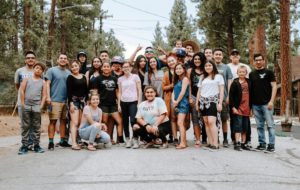
Conclusions
For anyone who loves the living Earth and is not in denial about what is happening, it may be tempting right about now to sink into despair and cynicism, writing off humans, our intelligence, and our ability to come into right relations with each other and the biosphere. That's understandable.
Futurist Barbara Marx Hubbard offers an insightful perspective, saying that we are in the troubled adolescent phase of our lifespan as a species. We are technologically precocious and full of energy, but have not yet mastered foresight or self-restraint. Astrophysicist Eric Chaisson has similarly spoken of this phenomenon as cosmic selection. Highly intelligent and technological species are likely to become premature overachievers, so successful that they rapidly destroy the ecological basis for their continued development. He offers cosmic selection as a reason for why despite the possibility of there being billions of life-bearing planets, the galaxy does not appear to be teeming with interplanetary travelers.
It remains to be seen whether humankind will emerge from of its adolescent phase, and if so, with how much collateral damage. For yes, in many ways things may get a lot worse before they get better --or at least at the same time as they get better. As the Anthropocene gathers steam, and it becomes increasingly difficult to sustain the unsustainable, some people may feel entitled to what they previously had, and may look for scapegoats and easy solutions. Along the way there will be voices (some loud, some obnoxious) that call for things like vanquishing our supposed enemies, doubling down on resource extraction, and generally returning to the good old days. Promises will be made, and troops will be rallied, all in the service of trying to maintain the "nonnegotiable" lifestyles and limitless consumption of humanity's adolescent phase.
The transition from adolescence to maturity has traditionally been earned through an initiation, often symbolized by what Joseph Campbell called the Hero's Journey. In our current case, we must make the journey not merely as lone individuals, but also as a collective. Ultimately humankind itself is the initiate, and the Great Turning is our metaphorical rite of passage. Typically a hero's journey begins with a call to adventure that the prospective hero can either respond to or refuse. Today the call is clear, unmistakable, and comes in various tongues from whales, from forests, from future generations of all species, and perhaps from the planet itself. As with all such rites there are both outer trials and inner fears to be faced and surmounted along the way, and our Anthropocene predicament will provide no shortage of such trials. With luck the hero is not totally alone on the journey, but finds support from protective elders and other allies that appear at just the right moment to share wisdom and special powers. In humanity's case, we have inherited the Epic of Evolution as a story to guide us along our journey. And we can find courage and strength by knowing that the evolutionary force is with us -- we need only look to the stars, to the living land and waters, or within ourselves and each other.
We need people who are ready to serve as protectors, wizards, leaders, and planetary elders. Navigating the difficulties of the Great Turning will take a certain maturity and tenacity of spirit. And this is not a matter of physical age -- some people are mature and wise beyond their years. We need people with the courage to speak truthfully about our evolutionary reality and our predicament, with neither cynicism nor naïve optimism; people who are willing to face the pain of our times with an open heart, and grieve as needed. We need bold souls who are willing to risk looking foolish by sharing positive visions that we can work together to create.
If you have read this far, maybe you are ready to find your allies, activate your evolutionary potential, and embark on a journey. Can you hear the call?

Key References
I'm grateful to those authors who have been writing about these topics in recent decades, all of whom I count as wise elders: people like Joanna Macy, David Korten, Richard Heinberg, Barbara Marx Hubbard, Carolyn Baker, Brian Swimme, and the late Thomas Berry.
A selection of references is listed below.
Books
The Universe Story (1992), by Thomas Berry and Brian Swimme
The Dream of the Earth (1988), by Thomas Berry
Journey of the Universe (2011), by Brian Swimme and Mary Evelyn Tucker
The Sacred Depths of Nature (1998) by Ursula Goodenough
Everybody’s Story, Wising Up to the Epic of Evolution (1999), by Loyal Rue
Conscious Evolution: Awakening the Power of Our Social Potential (2015) by Barbara Marx Hubbard
The New Universe and the Human Future: How a Shared Cosmology Could Transform the World (2012), by Nancy Ellen Abrams and Joel Primack
Epic of Evolution: Seven Ages of the Cosmos (2007), by Eric Chaisson
Big History: Between Nothing and Everything (2014), by David Christian, Cynthia Stokes Brown, and Craig Benjamin
Big History: From the Big Bang to the Present (2007), by Cynthia Stokes Brown
Coming Back to Life (2014), by Joanna Macy and Molly Brown
The Post-Corporate World (2000), The Great Turning: From Empire to Earth Community (2007), by David Korten, plus his other books and many articles at Yes! Magazine
Collapsing Consciously (2013) and Navigating the Coming Chaos: A Handbook for Inner Transition (2011), by Carolyn Baker.
Powerdown (2004), and The End of Growth (2011), by Richard Heinberg. Perhaps better than anyone, Heinberg explains the connections between energy, civilization, and our future.
Plus a couple books on biological evolution written for a popular audience:
The Greatest Show on Earth: The Evidence for Evolution (2009), by Richard Dawkins
Why Evolution Is True (2009), by Jerry Coyne
Websites
Thomas Berry and the Great Work. Photos, quotes, and a list of publications, including essays by Berry that can be read on the site. http://thomasberry.org/
The Great Story website. A community empowerment website created by Connie Barlow and Michael Dowd. Includes a large set of references and links to relevant topics. http://thegreatstory.org/what_is.html
Highlights include: "The Big Picture: The Larger Context for All Human Activities" a 1992 essay by Michael Dowd. http://www.thegreatstory.org/Bigpicture1.html and "Classic Quotations on the Epic of Evolution", compiled by Connie Barlow. http://thegreatstory.org/ClassicQuotes.pdf
Epic of Evolution website. Varied resources to learn about the Epic, with classroom-tested, hands-on activities, and reviews of books, videos, and teaching aids. http://epicofevolution.com/
Deep Time Journey Network. A global community exploring an Evolving Universe as a foundational context and offering online professional development programs; dedicated to orienting humankind to the great story of evolution as our primary context. https://deeptimejourney.org/
Resilience. Website of the Post Carbon Institute. Cutting edge site exploring energy transition, community resilience, and related topics, with new articles and discussions daily. http://resilience.org
Welcome to the Anthropocene. The world's first educational web portal on the Anthropocene. It aims to inspire, educate and engage people about the interactions between humans and the planet. http://www.anthropocene.info/
Living Economies Forum. https://davidkorten.org/
Joanna Macy and Her Work. https://www.joannamacy.net/main/
Carolyn Baker’s website, https://carolynbaker.net/. Also check out her podcasts, The Lifeboat Hour and The New Lifeboat Hour.
Videos and Courses
Journey of the Universe Narrated by Brian Swimme, and produced by Mary Evelyn Tucker and John Grim (2011). https://www.youtube.com/watch?v=-pjsJ5OFJlQ
Journey of the Universe, course series from Yale, based on the book by Brian Swimme and Mary Evelyn Tucker. Can be taken online at Coursera. Includes a third course on the work of Thomas Berry https://www.coursera.org/specializations/journey-of-the-universe
Journey of the Universe: Brian Swimme talk at Google. https://www.youtube.com/watch?v=YOlkkMxAhj4
Brian Swimme Cosmic Story video series https://www.youtube.com/watch?v=TRykk_0ovI0&list=PLEAE66D74118D75D5
2009 Terry Lectures: The New Universe by Joel Primack and Nancy Ellen Abrams. http://new-universe.org/zenphoto/LiveAction/2009-terry-lectures/TerryLecture_1b.txt.php
Big History Project website. A social science curriculum that includes resources for teachers and students, as well as a free 6-hour course for lifelong learners. This is financed by Bill Gates, and is very polished site for giving students a holistic view of natural and human history. Lacks useful political-economic analysis, or straight-talk on our present and potential future. https://school.bighistoryproject.com/bhplive
Other writings and websites referenced for this article.
António Guterres, UN Secretary-General, Remarks at the Austrian World Summit, May 15, 2018. UN News https://news.un.org/en/story/2018/05/1009782
Richard Heinberg “The New IPCC Report Offers Climate Solutions that Depend on Magic” Pacific Standard Magazine, Oct 8, 2018. https://psmag.com/environment/2018-ipcc-report-includes-magical-thinking
Richard Heinberg, "The Big Picture" at https://www.resilience.org/stories/2018-12-17/the-big-picture/
Kabir: Ecstatic Poems. Versions by Robert Bly (2004)
David Korten, Origin of the term “Great Turning” https://davidkorten.org/home/great-turning/origin-of-the-term/
Joel Mokyr. "The European Enlightenment, the Industrial Revolution, and Modern Economic Growth." 2007 essay. http://cadmus.eui.eu/bitstream/handle/1814/7631/MWP_LS_2007_06.pdf?sequence=1&isAllowed=y
Dominique Mosbergen, "Our Consumption Of Earth’s Natural Resources Has More Than Tripled In 40 Years" Huffington Post. https://www.huffingtonpost.com/entry/natural-resource-use-tripled_us_57a05c3ae4b0693164c273a8
Will Steffen et al "The trajectory of the Anthropocene: The Great Acceleration" Anthropocene Review. January 16, 2015. https://doi.org/10.1177/2053019614564785
